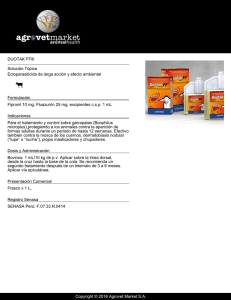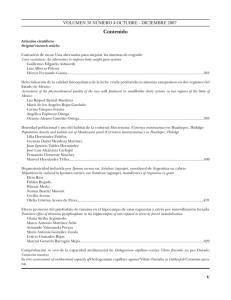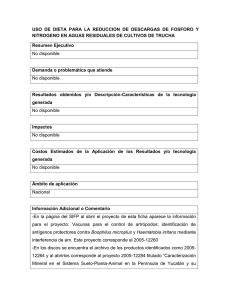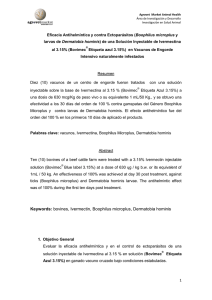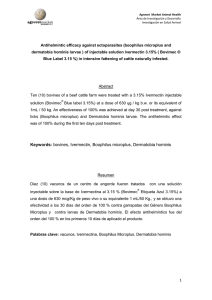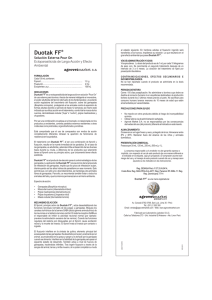rvm38410.pdf
Anuncio
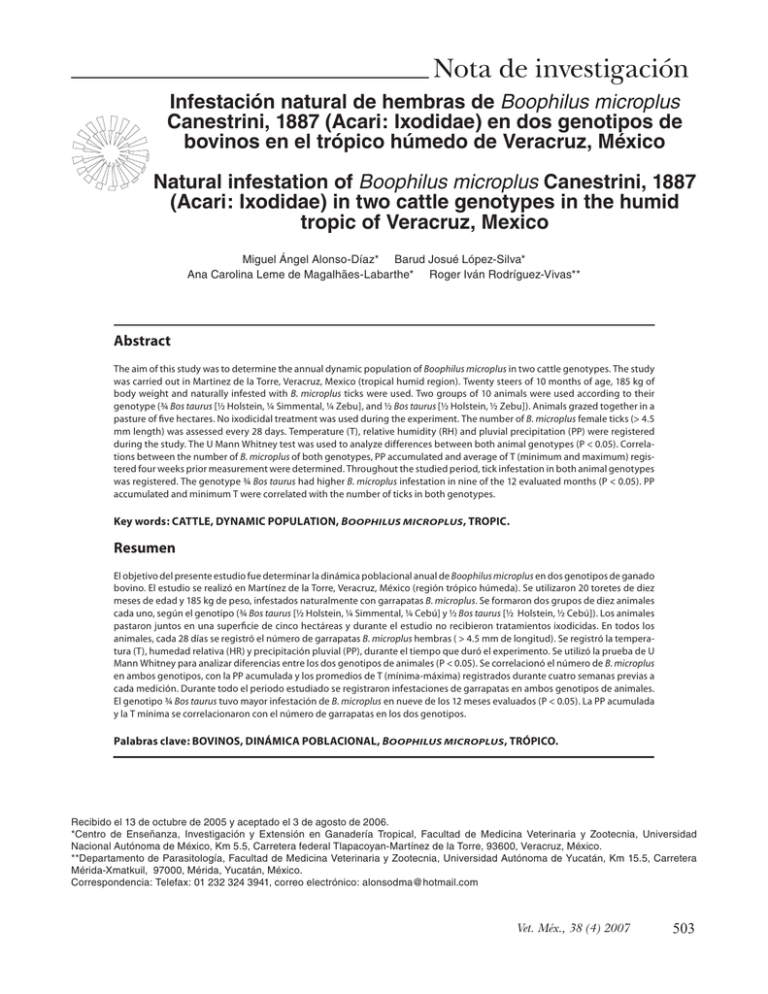
Nota de investigación Infestación natural de hembras de Boophilus microplus Canestrini, 1887 (Acari: Ixodidae) en dos genotipos de bovinos en el trópico húmedo de Veracruz, México Natural infestation of Boophilus microplus Canestrini, 1887 (Acari: Ixodidae) in two cattle genotypes in the humid tropic of Veracruz, Mexico Miguel Ángel Alonso-Díaz* Barud Josué López-Silva* Ana Carolina Leme de Magalhães-Labarthe* Roger Iván Rodríguez-Vivas** Abstract The aim of this study was to determine the annual dynamic population of Boophilus microplus in two cattle genotypes. The study was carried out in Martinez de la Torre, Veracruz, Mexico (tropical humid region). Twenty steers of 10 months of age, 185 kg of body weight and naturally infested with B. microplus ticks were used. Two groups of 10 animals were used according to their genotype (¾ Bos taurus [½ Holstein, ¼ Simmental, ¼ Zebu], and ½ Bos taurus [½ Holstein, ½ Zebu]). Animals grazed together in a pasture of five hectares. No ixodicidal treatment was used during the experiment. The number of B. microplus female ticks (> 4.5 mm length) was assessed every 28 days. Temperature (T), relative humidity (RH) and pluvial precipitation (PP) were registered during the study. The U Mann Whitney test was used to analyze differences between both animal genotypes (P < 0.05). Correlations between the number of B. microplus of both genotypes, PP accumulated and average of T (minimum and maximum) registered four weeks prior measurement were determined. Throughout the studied period, tick infestation in both animal genotypes was registered. The genotype ¾ Bos taurus had higher B. microplus infestation in nine of the 12 evaluated months (P < 0.05). PP accumulated and minimum T were correlated with the number of ticks in both genotypes. Key words: CATTLE, DYNAMIC POPULATION, BOOPHILUS MICROPLUS , TROPIC. Resumen El objetivo del presente estudio fue determinar la dinámica poblacional anual de Boophilus microplus en dos genotipos de ganado bovino. El estudio se realizó en Martínez de la Torre, Veracruz, México (región trópico húmeda). Se utilizaron 20 toretes de diez meses de edad y 185 kg de peso, infestados naturalmente con garrapatas B. microplus. Se formaron dos grupos de diez animales cada uno, según el genotipo (¾ Bos taurus [½ Holstein, ¼ Simmental, ¼ Cebú] y ½ Bos taurus [½ Holstein, ½ Cebú]). Los animales pastaron juntos en una superficie de cinco hectáreas y durante el estudio no recibieron tratamientos ixodicidas. En todos los animales, cada 28 días se registró el número de garrapatas B. microplus hembras ( > 4.5 mm de longitud). Se registró la temperatura (T), humedad relativa (HR) y precipitación pluvial (PP), durante el tiempo que duró el experimento. Se utilizó la prueba de U Mann Whitney para analizar diferencias entre los dos genotipos de animales (P < 0.05). Se correlacionó el número de B. microplus en ambos genotipos, con la PP acumulada y los promedios de T (mínima-máxima) registrados durante cuatro semanas previas a cada medición. Durante todo el periodo estudiado se registraron infestaciones de garrapatas en ambos genotipos de animales. El genotipo ¾ Bos taurus tuvo mayor infestación de B. microplus en nueve de los 12 meses evaluados (P < 0.05). La PP acumulada y la T mínima se correlacionaron con el número de garrapatas en los dos genotipos. Palabras clave: BOVINOS, DINÁMICA POBLACIONAL, BOOPHILUS MICROPLUS , TRÓPICO. Recibido el 13 de octubre de 2005 y aceptado el 3 de agosto de 2006. *Centro de Enseñanza, Investigación y Extensión en Ganadería Tropical, Facultad de Medicina Veterinaria y Zootecnia, Universidad Nacional Autónoma de México, Km 5.5, Carretera federal Tlapacoyan-Martínez de la Torre, 93600, Veracruz, México. **Departamento de Parasitología, Facultad de Medicina Veterinaria y Zootecnia, Universidad Autónoma de Yucatán, Km 15.5, Carretera Mérida-Xmatkuil, 97000, Mérida, Yucatán, México. Correspondencia: Telefax: 01 232 324 3941, correo electrónico: [email protected] Vet. Méx., 38 (4) 2007 503 Introduction Introducción B a garrapata Boophilus microplus se considera el principal ectoparásito que afecta al ganado bovino en las zonas tropicales1 y es responsable de la transmisión de Babesia bovis, Babesia bigemina y Anaplasma marginale, en Veracruz, México.2,3 Por su importancia económica y sanitaria, B. microplus ha sido la principal especie controlada en las campañas realizadas en México desde 1975.4 Actualmente, la problemática continúa y en algunas regiones se ha exacerbado por el desarrollo de cepas resistentes a los acaricidas.5,6 La mala utilización de los acaricidas y su elevada frecuencia de uso son los factores que más influyen sobre esta resistencia.5,7,8 Existen factores intrínsecos y extrínsecos a los animales que influyen directamente en la biología y ecología de B. microplus en los bovinos. Los factores intrínsecos más importantes son: sexo, raza, edad, tipo y color de pelo.9 Dentro de los factores extrínsecos se encuentran los efectos climáticos y las prácticas de manejo.10 La base para implementar un eficiente mecanismo de control es conocer las infestaciones naturales y la variación estacional que presentan las garrapatas en condiciones específicas de clima y manejo.11 En Morelos, México, Camino et al.12 presentaron información relevante para establecer programas de control de B. microplus en el ganado bovino. Sin embargo, en el trópico húmedo de Veracruz, se desconoce la dinámica de población de B. microplus en el ganado bovino durante el año, y en consecuencia el uso de ixodicidas se realiza de manera rutinaria sin considerar la población de garrapatas. Esto ha contribuido a la generación de cepas de garrapatas resistentes a los principales ixodicidas, como los organofosforados, piretroides y amidinas.13 Por tal motivo, el objetivo del presente estudio fue determinar la infestación natural de B. microplus en dos genotipos de ganado bovino sometidos a un mismo manejo en el trópico húmedo de Veracruz. El presente estudio se realizó de enero a diciembre de 2004, en un rancho bovino de Martínez de la Torre, Veracruz (Centro de Enseñanza, Investigación y Extensión en Ganadería Tropical de la Facultad de Medicina Veterinaria y Zootecnia de la Universidad Nacional Autónoma de México −CEIEGT-FMVZUNAM−). El clima de la zona es Af (m) w” (e) (trópico húmedo) con tres épocas definidas: 1) secas (febrero-mayo), 2) lluvias (junio-septiembre) y 3) nortes (invierno) (octubre-enero).14 En la zona predominan los sistemas extensivo y semiintensivo de producción, con pastoreo en pastizales nativos (Axonopus spp, Paspalum spp) y establecidos (Panicum maximum, Cynodon plectostachyus, Brachiaira brizantha, Brachiaria oophilus microplus tick is considered the main ectoparasite which affects bovine cattle in tropical zones1 and is responsible for the transmission of Babesia bovis, Babesia bigemina and Anaplasma marginale, in Veracruz, Mexico.2,3 For its economic and health importance, B. microplus has been the main controlled species in campaigns done in Mexico since 1975.4 Actually, the problematic continues and in some regions it has been exacerbated by the development of acaricide resistant strains.5,6 The misuse of acaricides and its elevated frequency use are the factors that influence more on this resistance.5,7,8 Intrinsic and extrinsic factors exist in animals which directly influence in the biology and ecology of B. microplus on bovines. The most important intrinsic factors are: sex, breed, age, hair color and type.9 Within the extrinsic factors, climatic effects and management practices are found.10 The basis to implement an efficient control mechanism is to know the natural infestations and seasonal variations which ticks present in specific climatic and management conditions. In Morelos, Mexico, Camino et al.12 presented relevant information to establish control programs of B. microplus in bovine cattle. Nevertheless, in the humid tropic of Veracruz, it is unknown the dynamic population of B. microplus in bovine cattle along the year; consequently, the use of ixodicides is consistently done without considering tick population. This has contributed to generate tick strains resistant to the basic ixodicides, such as organophophates, pyrethroids and amidines.13 For this reason, the aim of the present study was to determine the natural infestation of B. microplus in two genotypes of bovine cattle subjected to the same management in the humid tropic of Veracruz. The present study was done from January to December of 2004, in a cattle ranch of Martinez de la Torre, Veracruz (Learning Center, Investigation and Tropical Livestock Extension, Faculty of Veterinary Medicine and Husbandry of the National Autonomous University of Mexico –CEIEGT-FMVZ-UNAM ). The climate of the zone is humid tropic, with mean annual temperature of 24.4 °C, annual rainfall of 1990 mm and relative humidity of 85%, with three marked seasons: 1) dry (February-May), 2) rainy (June-September), 3) winter (October-January).14 Extensive and semi-intensive systems of production predominate the zone, with grassing on native grass (Axonopus spp, Paspalum spp) and established (Panicum maximum, Cynodon plectostachyus, Brachiaira brizantha, Brachiaria humidicola), supplemented when in grass shortage.15 Twenty male bovines were used because they present higher tick B. microplus infestations.9 Bovine had 10 504 L ± 2 months of age and 185 ± 23 kg of average weight. The animals presented natural infestations of B. microplus. Two groups of ten animals were each formed, according to the following genotypes: Group 1, animals with ¾ Bos Taurus (½ Holstein, ¼ Simmental and ¼ Zebu) genotype; Group 2, animals with ½ Bos taurus (½ Hostein and ½ Zebu) genotype. Each group was identified with different color rings and animals were identified through correlative numbers. The animals grazed in a 5 hectares area divided with an electrical fence in 14 pastures with established prairies with Cynodon plectostachyus (70%), Axonopus spp (15%) and Papalum spp (15%), which were previously occupied by natural infested bovines with B. microplus. Time of grazing in each pasture was of two days with rests of 28 days. Bovines were daily supplemented with concentrated feed (18% of crude protein) at a ratio of 1% of its weight, and they received salt minerals and ad libitum water. During the experiment, the animals received no acaricide treatment. The evaluation of the tick number was done by the individual inspection of each animal, and the number of female B. microplus (> 4.5 mm of length) was obtained by means of the technique described by Wharton and UTECO.16 The measurements were done from 6 to 8 a.m. since day 0 (beginning of experiment) and later on each 28 days during one year (from January to December of 2004). After each measurement, a sample of one to ten ticks was obtained from each animal, and then transported to an animal health laboratory from CEIEGT to corroborate its taxonomical classification in accordance to Rodriguez-Vivas et al.17 The mean ambient temperature (MAT) was recorded daily, minimum (min T°) and maximum (max T°), pluvial precipitation (PP) and relative humidity (RH), in a weather station located within the same property 150 m from where the animals grazed. To analyze the statistical differences (P < 0.05) between the number of B. microplus of the two genotypes studied, the U test of Mann Whitney was used.14 Likewise, the records of PP accumulated were correlated, and averages of MAT (T°min, T°max) and RH from one, two, three and four weeks previous to each measurement, with the measurements in the number of B. microplus, using Pearson’s test.18 The taxonomic classification of ticks in this study was B. microplus. In Figure 1, the number of female B. microplus is shown (> 4.5 mm of length) on both animal genotypes studied and its relation with climatic variables. Monthly RH, MAT and PP fluctuated from 70% to 77% from 11 to 35°C and from 10 to 300 mm, respectively. At the beginning of the experiment there was no significant difference in the number of ticks among genotypes (P > 0.05). Throughout the stud- humidicola), con complementación en época de escasez de pasto.15 Se utilizaron 20 bovinos machos debido a que presentan mayores infestaciones de garrapatas B. microplus.9 Los bovinos tenían 10 ± 2 meses de edad y 185 ± 23 kg de peso promedio. Los animales presentaron infestaciones naturales de B. microplus. Se formaron dos grupos de diez animales cada uno, de acuerdo con los siguientes genotipos: Grupo 1, animales con genotipo ¾ Bos taurus (½ Holstein, ¼ Simmental y ¼ Cebú); Grupo 2, animales con genotipo ½ Bos taurus (½ Holstein y ½ Cebú). Cada grupo fue identificado con aretes de colores distintos y los animales fueron identificados mediante números correlativos. Los animales pastaron en una superficie de cinco hectáreas divididas con cerca eléctrica en 14 potreros con praderas establecidas con Cynodon plectostachyus (70%), Axonopus spp (15%) y Papalum spp (15%), que fueron ocupadas previamente por bovinos infestados naturalmente con B. microplus. El tiempo de pastoreo en cada potrero fue de dos días con descansos de 28 días. Durante el periodo de estudio no pastorearon en las praderas otros animales domésticos. Los bovinos fueron complementados a diario con alimento concentrado (18% de proteína cruda) a razón de 1% de su peso vivo, y recibieron sales minerales y agua ad libitum. Durante el experimento los animales no recibieron tratamiento acaricida. La determinación del número de garrapatas se realizó mediante la inspección individual de cada animal, y el número de hembras adultas de B. microplus (> 4.5 mm de longitud) se obtuvo mediante la técnica descrita por Wharton y UTECO.16 Las mediciones se realizaron de 6 a 8 am a partir del día 0 (inicio del experimento) y posteriormente cada 28 días durante un año (de enero a diciembre de 2004). Después de cada medición, se obtuvo de cada animal una muestra de una a diez garrapatas, que fueron transportadas al laboratorio de sanidad animal del CEIEGT para corroborar su clasificación taxonómica de acuerdo con Rodríguez-Vivas et al.17 Diariamente se registraba la temperatura media ambiental (TMA), mínima (T°mín) y máxima (T°máx), precipitación pluvial (PP) y humedad relativa (HR), en una estación climática ubicada en la misma propiedad a 150 m de las praderas donde pastaban los animales. Para analizar las diferencias estadísticas (P < 0.05) entre número de B. microplus de los dos genotipos estudiados, se utilizó la prueba de U Mann Whitney.14 Asimismo, se correlacionaron los registros de PP acumulada, y los promedios de TMA (Tºmín, Tºmáx) y HR de una, dos, tres y cuatro semanas previas a cada Vet. Méx., 38 (4) 2007 505 ied period, the animals of both groups presented tick infestations (1.4-93.6 for ¾ Bos taurus genotype and 0.4-26.4 for ½ Bos taurus genotype) (Table 1). The lowest infestation was present in the months of January and November, and the highest in May. The lowest infestation coincided with winter season (13°C). The MAT, maxT° and RH averages during one, two, three and four weeks previous to each counting, were not correlated with the number of ticks (P > 0.05). The accumulated PP during one and two weeks previous to each counting correlated with the number of B. microplus in both genotypes (r2 = 0.74 and 0.72 in ¾ Bos taururs and r2 = 0.63 and 0.68 in ½ Bos taurus) (P < 0.05). The minT° average during three and four weeks previous to the counting correlated with the number of B. microplus (r2 = 0.60 and 0.53 in ¾ Bos Taurus and r2 = 0.65 and 0.65 in ½ Bos Taurus) (P < 0.05). In the present study, animals in both groups presented tick infestations throughout the year, and the population fluctuation showed the three peaks distribution that might correspond to new tick generations. In Brazil, while studying B. microplus ecology, Magalhaes19 and Lima et al.10 found four tick generations in one year. Under ideal temperature conditions, RH and PP, B. microplus can produce four or even five generaa) MaxTemp HR 78 76 74 72 Hº (%) Temperature ºC MinTemp 40 35 30 25 20 15 10 5 0 70 68 66 J F M A M J J A Month S O N D b) 1/2 European PP 400 300 200 100 PP milimeters No. of teleogines 3/4 European 100 80 60 40 20 0 0 J F M A M J J A S O N D Month Figura 1: a) Precipitación pluvial, humedad y temperatura registrada en el trópico húmedo mexicano (Martínez de la Torre, Veracruz) durante el periodo de estudio. b) Número de hembras de Boophilus microplus (> 4.5 mm de longitud) registrado en bovinos de dos genotipos en el trópico húmedo mexicano (Martínez de la Torre, Veracruz). Figure 1: a) Pluvial precipitation, humidity and temperature registered in the Mexican humid tropic (Martinez de la Torre, Veracruz) during the studied period. b) Boophilus microplus number of females (> 4.5 mm of length) registered in bovines of two genotypes in the Mexican humid tropic (Martinez de la Torre, Veracruz). 506 medición, con las mediciones en el número de B. microplus, utilizando la prueba de Pearson.18 La clasificación taxonómica de las garrapatas de este estudio fue B. microplus. En la Figura 1 se muestra el número de hembras B. microplus ( > 4.5 mm de longitud) en los dos genotipos de animales estudiados, y su relación con las variables climáticas. La HR, TMA y PP mensual fluctuó de 70% a 77%, de 11 a 35ºC y de 10 a 300 mm, respectivamente. Al inicio del experimento no hubo diferencia significativa en el número de garrapatas entre genotipos (P > 0.05). Durante todo el periodo estudiado, los animales de ambos grupos presentaron infestaciones de garrapatas (1.4-93.6 para el genotipo ¾ Bos taurus y 0.4-26.4 para el genotipo ½ Bos taurus) (Cuadro 1). La menor infestación se presentó en los meses de enero y noviembre, y la mayor en mayo. La menor infestación coincidió con la época de invierno (13ºC). Los promedios de TMA, Tºmáx y HR durante una, dos, tres y cuatro semanas previas a cada conteo, no se correlacionaron con el número de garrapatas (P > 0.05). La PP acumulada durante una y dos semanas previas a cada conteo se correlacionó con el número de B. microplus en los dos genotipos (r2 = 0.74 y 0.72 en ¾ Bos taurus y r2 = 0.63 y 0.68 en ½ Bos taurus) (P < 0.05). El promedio de Tºmín durante tres y cuatro semanas previas al conteo se correlacionó con el número de B. microplus (r2 = 0.60 y 0.53 en ¾ Bos taurus y r2 = 0.65 y 0.65 en ½ Bos taurus) (P < 0.05). En el presente estudio, los animales de ambos grupos presentaron infestaciones de garrapatas durante todo el año, y la fluctuación poblacional mostró la distribución de tres picos que quizá corresponden a nuevas generaciones de garrapatas. En Brasil, al estudiar la ecología de B. microplus, Magalhaes19 y Lima et al.10 encontraron cuatro generaciones de garrapatas al año. Bajo condiciones de temperatura, HR y PP favorables, B. microplus puede producir cuatro o hasta cinco generaciones al año.20 En el presente estudio, la mayor infestación de B. microplus ocurrió en mayo y junio, cuando las condiciones climáticas fueron favorables para el desarrollo de las garrapatas. Sin embargo, cuando la TMA fue menor a 20ºC (enero, febrero y diciembre), se observó un descenso en el número de garrapatas. El grado de infestación de los animales se relaciona con la influencia de los factores climáticos sobre la producción y sobrevivencia de estados no parasitarios.21,22 Se ha informado sobre el efecto de algunas variables climáticas en la dinámica poblacional de B. microplus. En el presente estudio hubo una correlación significativa entre el promedio de T°mín de tres y cuatro semanas previas al conteo y el número de garrapatas en los dos genotipos estudiados (P < 0.05). Rodríguez et al.20 mencionan que el invierno afecta negativamente las fases no parasitarias de B. microplus. Es probable que las bajas Cuadro 1 PROMEDIO DE HEMBRAS DE Boophilus microplus (> 4.5 MM DE LONGITUD) CUANTIFICADAS EN DOS GENOTIPOS DE BOVINO INFESTADOS NATURALMENTE EN EL TRÓPICO HÚMEDO MEXICANO (MARTÍNEZ DE LA TORRE, VERACRUZ) AVERAGE OF Boophilus microplus FEMALES (>4.5 MM OF LENGTH) QUATIFIED IN TWO GENOTYPES OF NATURALLY INFESTED BOVINE IN THE MEXICAN HUMID TROPIC (MARTINEZ DE LA TORRE, VERACRUZ) Months of the year Genotype ¾ Bos taurus ½ Bos taurus J F M A a 14.0ª 27.2ª 9.2 6.0b 12.0b 8.0a M a J a J a A a S a O a N a D a 22.0a 11.7b 31.0 93.6 84.0 38.2 16.8 57.6 28.6 1.4 13.0b 24.4b 26.4b 15.6b 11.4a 25.8b 13.0b 0.4a Different letters within column indicate statistically significant difference (P < 0.05) tions in one year.20 In the present study, the highest B. microplus infestation occurred in May and June, when climatic conditions were favorable for the development of ticks. Nevertheless, when MAT was lower than 20°C (January, February and December), a decrease in the number of ticks was observed. The degree of infestation in animals is related with the climatic factors influenced over the production and survival of non parasite states.21,22 It has been informed over the effect of some climatic variables on the dynamic population of B. microplus. In the present study, there was a significant correlation between the average of minT° of three and four weeks previous to counting and the number of ticks in both genotypes studied (P < 0.05). Rodriguez et al.20 mention that winter negatively affects non parasite phases of B. microplus. It is probable that low temperatures in winter in the humid tropic of Veracruz, Mexico, affect egg laying, hatch and larva viability of B. microplus periods. PP is one of the main factors that influence the dynamic population of B. microplus. Quijada et al.23 mention that the greatest tick population coincides with draught and during the rainy season tick number declines. In Jamaica,24 Brazil10,25 and Venezuela26 it was found that heavy precipitation affects the number of ticks, maybe due to the lixiviation caused by heavy rain. In this work, it was observed that monthly PP > 200 mm caused a decrease in tick number (June and September) and monthly PP from 100 to 150 mm favored greater infestation in animals. This is the first study in the humid tropic of Veracruz, where it is indicated that heavy precipitations in the rainy season diminish the B. microplus population. Infestation of B. microplus in ¾ Bos taurus genotype was higher in nine of the 12 evaluated months (P < 0.05) (Table 1). Independently of management, the genotype of bovines is another factor that influences temperaturas en invierno en el trópico húmedo de Veracruz, México, afecte los periodos de oviposición, eclosión y viabilidad larvaria de B. microplus. La PP es uno de los principales factores que influyen sobre la dinámica poblacional de B. microplus. Quijada et al.23 mencionan que la mayor población de garrapatas coincide con la sequía y durante la temporada de lluvias el número de garrapatas declina. En Jamaica, 24 Brasil10,25 y Venezuela26 se encontró que las elevadas precipitaciones afectan el número de garrapatas, quizá debido a la lixiviación que ocasiona la alta precipitación. En este trabajo se observó que PP > 200 mm mensual ocasiona disminución en el número de garrapatas (junio y septiembre) y PP de 100 a 150 mm mensual favoreció mayor infestación en los animales. Éste es el primer trabajo en el trópico húmedo de Veracruz, donde se indica que las altas precipitaciones en la época de lluvia disminuyen la población de B. microplus. El genotipo ¾ Bos taurus tuvo mayor infestación de B. microplus en nueve de los 12 meses evaluados (P < 0.05) (Cuadro 1). Independientemente del manejo, el genotipo de los bovinos es otro factor que influye en los niveles de infestación de B. microplus.11,23 En el presente estudio se observó que los animales con genotipo ¾ Bos taurus presentaron mayor infestación de garrapatas (P < 0.05) en nueve de los 12 meses evaluados. Este hallazgo coincide con Sutherst11 y Castro, 27 quienes encontraron que las razas cebú (Bos indicus) presentan mayor resistencia a garrapatas en relación con las razas europeas (Bos taurus). Se concluye que la infestación de B. microplus en bovinos del trópico húmedo de Veracruz, requiere mayor control durante mayo a septiembre, y que el genotipo ¾ Bos taurus presenta mayor infestación que los bovinos con genotipo ½ Bos taurus bajo un mismo manejo zootécnico. Vet. Méx., 38 (4) 2007 507 on B. microplus infestation levels.11,23 In the present study, it was observed that animals ¾ Bos taurus genotype presented greater tick infestation (P < 0.05) in nine of the 12 evaluated months. This finding coincides with Sutherst11 and Castro27 who found that Zebu breeds (Bos indicus) presented greater tick resistance in relation to European breeds (Bos Taurus). It is concluded that B. microplus infestation on bovines from the humid tropic of Veracruz, requires greater control during May and September, and that ¾ Bos taurus genotype presented greater infestation that bovines with ½ Bos taurus genotype under the same animal management. Referencias 1. Rodríguez-Vivas RI, Domínguez-Alpízar JL. Grupos entomológicos de importancia veterinaria en Yucatán, México. Rev Biomed 1998; 9:26-37. 2. Cossio-Bayugar R, Rodriguez SD, Garcia-Ortiz MA, Garcia-Tapia D, Aboytes-Torres R. Bovine anaplasmosis prevalence in northern Veracruz state, Mexico. Prev Vet Med 1997; 32 :165-170. 3. Figueroa JV, Alvarez JA, Ramos JA, Rojas EE, Santiago C, Mosqueda JJ et al. Bovine babesiosis and anaplasmosis follow-up on cattle relocated in an endemic area for hemoparasitic diseases. Ann N Y Acad Sci 1998; 849: 110. 4. Solís SS. Ecología de las garrapatas Boophilus: Perspectivas de un panorama. Memorias de II Seminario Internacional de Parasitología Animal. Garrapatas y enfermedades que transmiten; 1991 octubre 9-11; Oaxtepec (Morelos) México. México (DF): Secretaría de Agricultura y Recursos Hidráulicos, 1991:19-30. 5. Alonso-Díaz MA. Prevalencia y factores de riesgo de ranchos bovinos con garrapatas Boophilus microplus resistentes a piretroides en el estado de Yucatán, México (tesis de maestría). Mérida (Yucatán) México: Universidad Autónoma de Yucatán, 2002. 6. Rodríguez-Vivas RI, Alonso-Diaz MA, Rodriguez-Arevalo F, Fragoso-Sanchez H, Santamaria VM, Rosario-Cruz R. Prevalence and potential risk factors for organophosphate and pyrethroid resistance in Boophilus microplus ticks on cattle ranches from the state of Yucatan, Mexico. Vet Parasitol 2006. 136: 335-442 7. Georghiou GP, Taylor CE. Operational influences in the evolution of insecticides resistance. J Econ Entomol 1977; 70: 653-638. 8. Jonsson NN, Mayer DG, Green PE. Possible risk factors on Queensland dairy farms for acaricide resistance in cattle tick (Boophilus microplus). Vet Parasitol 2000; 88: 79-92. 9. Martinez ML, Machado MA, Nascimento CS, Silva MV, Teodoro RL, Furlong J et al. Association of BoLADRB3.2 alleles with tick (Boophilus microplus) resistance in cattle. Genet Mol Res 2006; 5: 513-524. 10. Lima WS, Ribeiro MF, Guimaraes MP. Seasonal variation of Boophilus microplus (Canestrini, 1887)(Acari: Ixodidae) in cattle in Minas Gerais State, Brazil. Trop Anim Health Prod 2000; 32: 375-380. 508 11. Sutherst RW. Resistance of cattle to ticks and one element in control programme in Mexico. FAO Animal Production and Health Paper 1989:154-164. 12. Camino LM, Butler JF, Guerrero RR, Quintero MMT. Development of an integrated pest management system for the cattle tick Boophilus microplus (Canestrini) in Morelos State, Mexico. Acarology 1979; 6: 1220-1231. 13. Neri-Orantes S, Fragoso SH, Ortiz NA, Osorio MJ, Martínez IF, Quezada DR et al. Epidemilogy of amitraz resistance in the cattle tick Boophilus microplus in Mexico. V International Seminar in Animal Parasitology, World Situation of Parasite Resistance in Veterinary Medicine. 2003 octubre 1-3 Merida, Yucatan, Mexico. Merida (Yucatan) Mexico: SENASICA-INIFAP-INFARVETUADY-FAO-AMPAVE. 14. García E. Modificaciones del sistema de clasificación climática de Köppen (para adaptarlo a las condiciones de la República Mexicana). 2da Reimp. México (DF): Instituto de Geografía, UNAM, 1981. 15. Instituto Nacional de Estadística, Geografía e Informática. VII Censo ganadero agrícola 1991 (monografía en CD-ROM). Resultados definitivos. Tomo 2 Ganado y ganadería-México-Estadística.México (DF): INEGI; 1991. 16. Wharton RH, Utech KBW. The relation between engorgement and dropping of Boophilus microplus (Canestrini) (Ixodidae) to assessment of tick numbers on cattle. Aust J Entomol 1970; 9:171-182. 17. Rodríguez-Vivas RI, Domínguez AJ, Cob GL. Técnicas Diagnósticas de Parasitología Veterinaria. Mérida (Yucatán) México: Universidad Autónoma de Yucatán, 1994: 131-140. 18. Statistical Analysis Systems Institute Inc. SAS User guide: Statistics Version Release 6.03 edition; Cary, North Caroline, USA. SAS 1991 Institute Inc., p. 1029. 19. Magalhaes FEP. Aspectos biológicos, ecológicos e de controle do Boophilus microplus (Canestrini, 1887) no municipio de Pedro Leopoldo –Minas Gerais– Brazil (tesis de doctorado). Minas Gerais (Brazil): Universidad Federal de Minas Gerais, Brazil, 1989. 20. Rodríguez-Vivas RI, Quiñones AF, Fragoso-Sánchez H. Epidemiología y control de la garrapata Boophilus en México. En: Rodríguez-Vivas RI, editor. Enfermedades de importancia económica en producción animal. México DF: McGraw-Hill-UADY, 2005: 571-592. 21. Ivancovich JC. Bioecología de la garrapata del ganado Boophilus microplus (Canestrini, 1887). Rev Invest Agropec 1978;12:1-54. 22. Solís SS. Diversidad, distribución y abundancia de garrapatas en México. Campaña contra la garrapata. Instructivo Técnico. México (DF): SAGAR-CNMVZ, 1993:27-35. 23. Quijada T, Contreras J, Coronado A. Dinámica poblacional de Boophilus microplus Canestrini, 1887 (Acari: Ixodidae) en bovinos doble propósito en las Yagas, Estado Lara, Venezuela. Arch Latinoam Prod Anim 1997; 5:597-600. 24. Rawlins SC. Seasonal variation in the population density of larvae of Boophilus microplus (Canestrini) (Acari: Ixodidae) in Jamaican pastures. Bull Entomol Res 1979; 69:87-91. 25. Moreno EC. Incidência de ixodideos em bovinos de leite e prevalêcia em animais domésticos da regiao metalurgica de Minas Gerais (tesis de doctorado). Minas Gerais (Brazil). Universidad Federal de Minas Gerais, Brazil, 1984. 26. Gallardo VJS, Morales J. Incidencia de Boophilus micro- plus y Amblyomma cajennese, y dinámica poblacional de B. microplus (Acari: Ixodidae), en el municipio de Morán, Estado de Lara. Bio agro 1999;11:51-60. 27. Castro JJ. Sustainable tick and tickborne disease control in livestock improvement in developing countries. Vet Parasitol 1997; 71: 77-97. Vet. Méx., 38 (4) 2007 509
